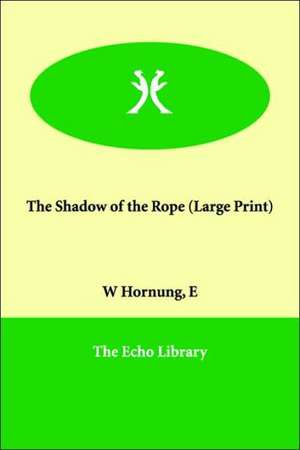The Shadow of the Rope
Autor E. W. Hornungen Limba Engleză Paperback – 4 dec 2005
| Toate formatele și edițiile | Preț | Express |
|---|---|---|
| Paperback (9) | 51.98 lei 3-5 săpt. | |
| CREATESPACE – | 51.98 lei 3-5 săpt. | |
| – | 67.74 lei 3-5 săpt. | |
| – | 72.77 lei 3-5 săpt. | |
| CreateSpace Independent Publishing Platform – 6 dec 2015 | 72.85 lei 3-5 săpt. | |
| CREATESPACE – | 99.52 lei 3-5 săpt. | |
| – | 105.26 lei 3-5 săpt. | |
| Bottom of the Hill Publishing – 31 mai 2015 | 106.80 lei 3-5 săpt. | |
| Alpha Editions – 6 sep 2017 | 96.76 lei 6-8 săpt. | |
| Echo Library – 4 dec 2005 | 226.72 lei 39-44 zile |
Preț: 226.72 lei
Nou
Puncte Express: 340
Preț estimativ în valută:
43.41€ • 44.78$ • 35.98£
43.41€ • 44.78$ • 35.98£
Carte tipărită la comandă
Livrare economică 17-22 februarie
Preluare comenzi: 021 569.72.76
Specificații
ISBN-13: 9781846372230
ISBN-10: 1846372232
Pagini: 444
Ilustrații: black & white illustrations
Dimensiuni: 152 x 229 x 25 mm
Greutate: 0.65 kg
Ediția:Text mare
Editura: Echo Library
Locul publicării:United Kingdom
ISBN-10: 1846372232
Pagini: 444
Ilustrații: black & white illustrations
Dimensiuni: 152 x 229 x 25 mm
Greutate: 0.65 kg
Ediția:Text mare
Editura: Echo Library
Locul publicării:United Kingdom
Notă biografică
Author and poet Ernest William Hornung was born on June 7, 1866, in Marton, Middlesbrough. Hornung was given the nickname Willie at a young age. The A. J. Raffles series of tales, which center on a gentleman burglar in late 19th-century London, is what made him most famous. His friends Lord Alfred Douglas and Oscar Wilde, as well as Sherlock Holmes and Dr. Watson, served as inspiration for several of the characters. In 1898, he published ""In the Chains of Crime,"" which introduced Bunny Manders and Raffles. In 1899, the collection of Raffles' short stories was published as a book for sale. In addition to his Raffles tales, Hornung was a prolific fiction author who produced a large number of works between 1890 and 1914. He wrote a lot when he was in France; his son, Oscar, was killed at the Second Battle of Ypres in July 1915. The strain of his wartime duties significantly deteriorated Hornung's already poor constitution. On the train, he had a chill that developed into influenza and pneumonia, which led to his death on March 22, 1921, at the age of 54. In the south of France, in Saint-Jean-de-Luz, he was laid to rest.
